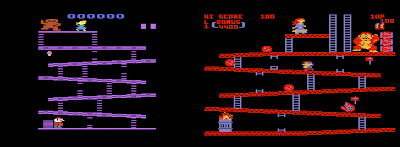The amazing computer you see at your left is the Atari 800XL. After
the Atari 2600 dominated the early video game market, Atari started to
dip its toe in the home computer market in order to compete with the
Apple II, TI-99, and the early Commodore line. Their first 8-bit
computers were the Atari 400 and 800. These were followed by improved
machines like the Atari 800XL whose main competitor was the Commodore
64.
The reason I bring all this stuff up is not to flex
my mental muscles with my knowledge of early home computers (If that
isn't nerdy crap, I don't know what is) it's because the Atari 800XL is
the computer my family owned when I was a kid. I learned to program on
that machine. I developed a mildly bewildering addiction to Galaxian on
that machine. When my family graduated to 386 and 486's, my Mom
(unbeknown to me, I might add) boxed up the old Atari and sold it, its
peripherals, and all its games to a neighbor. Many years later when I
was a bachelor with money burning a hole in his pocket I bought my own
Atari 800XL, a 5.25" disk drive, a bunch of blank disks, and an SIO2PC
cable that allows my Atari to interface with my current PC (here are a
couple websites if this sounds like the kind of nerdy crap you'd like to
get into: Atarimax who sells the SIO2PC adapter, and Atarimania which has an archive of all the Atari games you'll ever want. You can find everything else on the bay).
Anyway,
I'm a fairly avid collector of vintage video games. I know I can play
just about any game I want on an emulator, but there's something about
holding the old one-button Atari joystick in your hand that's a whole
lot better than anything any emulator can give.
The 8-bit Atari lineup is a great part of computing history. Very few of the competitors of the Atari 8-bit line still have an active community, and for those that do, very few of them have produced the quality hardware and software the Atari communities have (take that all you c64 lovers). People in Poland, the Czech Republic, Germany, and many other places are still crazy about 8-bit Atari and are still developing new games that push the system to (and sometimes beyond) its limits.
If you've played the Atari 2600 (it was the most popular console on earth for a while, so chances are you have) you may think you know what 8-bit Atari is all about. Here's the thing: much as I love the 2600 and all its blocky charm, the 8-bit Atari line was able to make games that looked, sounded, and played two to three times better than their Atari 2600 counterparts. Take a look at the pictures below.
On the left you have the Atari 2600 version of Donkey Kong in which Kong might be some sort of poorly-drawn alien. The ladders are choppy, and the burning oil can is a purple box. On the right you have the 8-bit version, which is highly faithful to the arcade original. It's not 100% exactly the same as original version, but it's very close.
On the left you can see the Atari 2600 version of Pac-Man, which is largely regarded as one of the worst adaptations of any arcade game on any console. Its visuals are atrocious, its gameplay is choppy at best, and the maze is all wrong. The 8-bit Atari version looks incredibly similar to the arcade version. The maze is slightly stretched horizontally and the ghosts don't have the white eyes of the arcade version. Aside from that, the 8-bit version is exactly like its arcade counterpart.
Don't get me wrong. I love the Atari 2600. It was an amazing system for its time, and a necessary piece of gaming history. There are plenty of great titles for the 2600. I just wanted to show that the 8-bit Atari line provides excellent gaming with near-perfect arcade faithful graphics. The 8-bit Ataris also have a whole bunch of games which simply could not be played on the 2600. There's plenty to love about the 8-bit Ataris. I'm partial to the 800XL and will recommend it to anyone patient enough to listen.




No comments:
Post a Comment